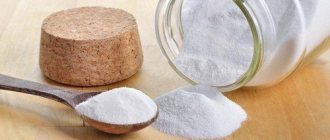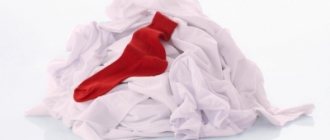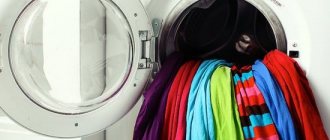Home / Care
Back
Published: 05/20/2021
Reading time: 2 min
0
14
Every housewife knows that when washing, you need to take into account the color of things and the type of material from which they are made. Some combinations are undesirable because they can worsen the condition of fabric products. Before washing black clothes, you should clarify what these clothes can be combined with and which options are best avoided.
- 1 Washing black with items of a different color
- 2 Correct mode and temperature
- 3 Choice of product
- 4 What to do if white streaks remain after washing
- 5 Conclusion
Washing black with items of a different color
The table shows acceptable and undesirable combinations of dark clothing with other products:
| Item color | Acceptable and undesirable combinations |
| With white | Combining contrasting options is not recommended. As a result of such processing, light-colored items most often acquire a grayish tint. They are also often washed with bleaching agents, which are strictly contraindicated for dark clothes. |
| With gray | Black items can be washed with dark gray clothes. It is better not to combine options that have a light gray tint. You can wash gray and darker items if they are made of similar fabric. |
| With color | It is not recommended to wash black and colored items, as the second type of item may fade. If washing in the machine turns out to be combined, there should be much less dark clothes than multi-colored ones. |
You can wash black items with blue ones if the tone of the latter is dark enough. If the shade approaches blue, it is better to separate them.
In some cases, it is still possible to combine black and white. This is done if dark products have already gone through several treatments, faded a little and lost their original color. This is also acceptable for quick washing that does not involve the use of aggressive detergents.
Note to the hostess
- When caring for items, special attention should be paid to the instructions on the tag or label.
- Always follow the temperature recommendations, otherwise the color of the product may change.
- Sort items correctly: it is recommended to wash red items together with items colored in purple, orange, and yellow shades; blue with green things. If there are only a few colored items, you can wash them by hand.
- All items must be turned inside out before washing. This measure will help protect things from shedding.
- Do not fill the drum completely.
- Bright clothes do not tolerate hot water, so it is recommended to wash them in modes with a maximum temperature of no higher than 40 degrees.
- Under no circumstances should items be left in the washing machine drum after the end of the washing program. This can lead to damage to things: they may fade.
- Do not use care products containing chlorine.
- Place colored items spaced apart on the dryer.
Colored products help us look stylish and bright in any situation. To keep things looking attractive for a long time, it is important to wash them correctly! Simple recommendations for caring for colored items will ensure their original appearance.
Correct mode and temperature
When washing, follow certain rules:
- Dark clothes. Black items should be washed at a temperature of 30-40 C°. In this case, it is better to use liquid products. Dry substances are undesirable because they often leave streaks on the fabric. If there are stains, use salt, glycerin, and alcohol.
- White products. For light colors, liquid products or dry powders are suitable. Bleach is used to restore color. The optimal water temperature is 30-60 degrees. Contaminants are removed with soda, ammonia, and laundry soap.
- Black and white items (with inserts). Hand wash recommended. Powders are prohibited. The water should have a temperature of no more than 30 °C.
Co-washing contrasting items is carried out only in a gentle cycle. It is best to use cold water for processing. Pre-soaking is prohibited.
Advice! To preserve the color of black clothes when machine washing, place half a glass of salt or 2 tsp in the drum. ground pepper. For manual processing, use coffee or tobacco (15 g per 1 liter of boiling water).
Handwash
To wash colored items by hand, you need to follow these simple steps:
- Prepare a bowl or basin.
- Take water at room temperature.
- Add mild detergent.
- If necessary, soak the products first.
- Place the item in water with detergent and wash it with gentle movements.
- Rinse with cool water and water softener.
- Dry.
- It is important to wash things with rubber gloves.
The hand wash mode is gentle, so your colored items will delight you with their shades for a long time!
Choice of product
For dark colors, it is recommended to choose products marked “For Black”. Such products are created on the basis of formulas that help the fabric not fade. Products are cleaned using powders (Aist Black, Proprete Black & Dark, Sano Maxima Black) and gels (Laska 3D, Burti Noir, Perwoll black Renew).
Light colors are processed using products containing bleaching components. Popular powders include PERSIL PREMIUM, LION BEAT ECONO MAX. Whitening gels include BIOMIO BIO-2B1, ATTITUDE MOUNTAIN ESSENTIALS 2 IN 1. GARDEN KIDS powder containing silver ions is suitable for children's underwear.
Advice! If contrasting items are washed together, it is worth using neutral substances. For this treatment, mild products without bleaching compounds are suitable.
How to wash dark clothes
Before washing, you need to sort things by fabric and tone. Ideally, each color is loaded into the machine separately to prevent the clothes from fading. The following combinations are not allowed:
- white with black and blue;
- gray or red + black;
- dark and colorful.
Like any other linen, you can wash dark-colored items by hand or in an automatic machine. Which method to choose is up to you.
Wash by hand
This type of washing doesn’t have any special tricks, so it’s quite simple to do:
- Prepare two spacious basins into which you can load several things at once. Or use a sink.
- The containers need to be filled three-quarters full with water, maintaining a temperature of approximately 30 degrees. Clothes fade in hotter liquids.
- In the first basin, the required detergent is completely dissolved (at the rate of 1-2 tsp per product).
- The clothes are placed in water and stirred little by little to rid the fibers of dirt. Try to foam the product well and do this for about 5 minutes until the matter is cleansed.
- Next, the product is removed, gently wrung out and transferred to a container with tap water. You need to rinse, vigorously lifting and returning to the liquid, for about 5 minutes. Repeat the steps, replacing the water until it runs clear.
- Manufacturers do not recommend twisting things. The best way is to remove moisture by gravity.
- It is better to dry clothes on a horizontal surface or a hanger, and use a rope as little as possible (it contributes to uneven stretching of the fabric).
How and at what temperature to wash in an automatic machine
Before putting clothes in the drum, read the label to make sure that this method will not damage them. The following recommendations will help you figure out how to properly wash black linen in a machine:
- Do a shedding test on an inconspicuous area: moisten the underside with water and wipe with a white cloth. If dark marks remain on it, then the dye used is unreliable.
- Before washing, you need to let the drum idle for about 10 minutes. This is an effective method that eliminates the formation of pellets and fluffing of villi.
- On any clothing you need to fasten the buttons and hooks, and turn it inside out.
- Load the drum 2/3 full. This will improve the quality of washing, rinsing and spinning.
- Wash dark items separately from colored items, even if they do not fade.
- Before the process, study the composition of the fabric and choose a mode based on this. Experts do not recommend setting temperatures above 40 degrees for any fabrics.
- If you find stains, use a non-aggressive, chlorine-free stain remover.
- Dry things naturally in a shaded place.
What to do if white streaks remain after washing
Unsightly marks are most often left behind when black items are washed in the washing machine. Such stains are removed while the item is still damp. The product is again loaded into the machine and an additional rinse is carried out. It is performed twice - with high-quality fabric softener and clean water. To prevent the appearance of white streaks, clothes are washed inside out. It is also necessary to use liquid detergents. It is better to rinse by hand. If this is done in a machine, the procedure should be repeated at least three times in a row.
Rules for caring for black products
Before you start washing in the washing machine, prepare your items. Of course, first of all, separate delicate fabrics (underwear, silk underwear) from jackets and jeans.
- Clear your clothing pockets of foreign objects.
- Always turn things inside out. The dye tends to be washed out, and the fibers tend to be damaged by mechanical stress. By turning your clothes inside out, you protect the fabric from fading quickly.
- What mode should I use to wash things? For cotton trousers, shirts, pants, set a quick, daily wash, as well as the “Cotton” program. Delicate dresses, jackets, and underwear should be washed on a delicate or hand wash cycle.
It is recommended to do the first wash by hand to find out how the item will behave when wet.
- If you don't know what temperature to properly care for your clothes, look at the label. It is better to wash black items in cool water (30-40 degrees). Warm water in this case promotes discoloration of the fibers.
- Do not overload the drum with laundry. The fewer items there are, the easier it is for the machine to rinse them. Otherwise, white stains will constantly remain on your clothes.
- Spin is carried out in accordance with the selected mode. Do not forget that it is better not to wring out delicate fabrics made of silk and cashmere.
Selecting a detergent
What powder should I use to wash black clothes? It is better to use liquid detergents for dark clothes. They help maintain color durability. These can be gels for delicate fabrics or universal products. Since washing is carried out in cold water, the powder does not dissolve well in it, so streaks cannot be avoided. The best way to care for your products:
- Dreft.
- Cotoco.
- Weasel.
- Clean Home.
- Villi.
- Bimax.
When choosing a product in capsules, throw it directly into the drum. Pour bottled gels into the dispenser tray according to the instructions.
Getting rid of stains
Various spots are clearly visible on the black. There are home remedies to remove them. First apply the product to the stain and then load it into the washer.
- Get rid of old deodorant stains with regular vodka.
- Salt diluted in cold water perfectly removes blood stains.
- Dishwashing gel will help get rid of grease stains.
- Water with glycerin (1:1) will remove ice cream stains.
We have already told you at what degrees you can wash dark clothes. Also make sure that clothes do not stay in water for too long.
Restoring color brightness at home
For products of different colors, different means are suitable to maintain their brightness:
- rinse yellow, pink and blue fabrics in a 9% vinegar solution (125 ml of vinegar per 6 liters of water);
- Rinse blue and red clothes with soda (add a small spoon of soda per liter of water);
- rinse green laundry in a solution based on alum (one large spoon of alum per 5 liters);
- Rinse brown and cream clothes in a solution based on tea leaves (its color is selected taking into account the tone of the item).
https://www.youtube.com/watch?v=ytdevru
You can add the same brightness to blue clothes using blue. It dissolves in water to a shade that matches the color of the item.
Is it possible to wash whites with colors?
Often designers, trying to make clothes more attractive in appearance, add various colored inserts to the white background of the clothes. In addition, it is always tempting to save time and energy by washing white and “almost white” items together.
When you wash beige and white, you can rest assured that the color will be preserved; the pigments of these paints are practically not transferred, but if the recommendations on the label are not followed, things may become more faded. If it’s impossible to avoid mixing white and colored fabrics together, then let’s look at how to minimize the risk of color discolouration.
Don't mix dark and light things together. Avoid mixing white and red fabrics if you want to avoid unplanned pink items in your wardrobe.
Washing together with dark blue clothing will give the previously white fabric a blue tint. If you decide to combine white items with colored ones, try to choose the most gentle mode at low temperature and low spin.
Do not leave white items in the machine together with colored items after washing. This will help, if clothes of a different color have faded, to avoid color transfer to the white fabric. Therefore, after receiving a signal that the machine has finished operating, try to immediately hang things up to dry.
Choose the right auxiliary products for multi-colored clothing. Washing powders, conditioners and stain removers should be suitable for brightly colored fabrics; look for a note about this on the packaging. The special composition will preserve the rich color and will not spoil the structure of the fabric.
Is the new item subject to shedding?
Usually, manufacturer's labels sewn into the inside cause discomfort when worn, so people cut them off after purchasing the item. And then you can’t take it and read whether the material is fading. There are two ways to find the answer to this question.
Sometimes manufacturers sew a small piece of fabric into the inside of the garment. If you have a “sample”, cut it and moisten it with ammonia. Next, wait 10-20 minutes. Then rinse the flap and dry it. If the color has not changed, the material does not fade.
If there is no sewn-in piece of fabric, the check is performed in a different way. Wet a small area with water, place a white paper towel on top and iron the area. If the sheet is not colored, then the product does not fade.
Denim tends to fade even after several washes, so it should be washed separately from other laundry.
Distribution by functional features
The final stage of sorting will be identification by functional features. Most of these rules are known to everyone, since they are quite logical, but it will not hurt to familiarize yourself with them:
Bad combination .
Shoes, such as sneakers, are always washed separately. Children's clothing is sent to a separate category. Curtains, curtains, blankets, blankets, jackets and down jackets - separately. Heavily soiled items and those that require light washing are also separated.- Good combination . Bed linen belongs to a separate category; it is permissible to add terry towels. Jeans - only with socks. The rest is selected according to shade, material, and total weight.
We separate one from the other according to the type of fabric
For the different materials from which clothes are made, there are certain recommendations for choosing a washing product and choosing the right mode. Some categories can be combined, but there are materials that are best washed separately or even by hand.
Suitable for co-washing:
- cotton, linen, chintz items;
- wool and cashmere clothing;
- synthetics cannot be combined with other types - polyester, nylon, acrylic, polyamide, viscose, synthetic velor.
But fleece, artificial silk, tulle, silk, and lace belong to a separate category and cannot be combined at all.
Delicate fabrics should always be washed separately, preferably by hand. For these cases, purchase special products separately and pay special attention to studying the label from the manufacturer.
We remove different types of stains
On shirts and T-shirts, yellow spots most often appear in the armpit area. Also, traces of drinks often remain on things. Often there is a need to wash things from rust and grease stains. Contamination from pens and felt-tip pens is especially corrosive.
Yellow under the arms
To remove traces of sweat from things, it is recommended to use alcohol. To do this you need:
take 96% alcohol and dilute it in water - just dilute 120 g of alcohol in 220 g of water;- soak a cotton pad in the solution;
- apply it to the yellow spot around the entire perimeter;
- wait a couple of hours;
- wash the product.
It is allowed to add a small spoon of salt to the alcohol solution.
From drinks
To remove traces of tea from things, it is recommended to use vinegar.
- Take a large spoon of vinegar and mix it with ½ small spoon of dish soap.
- Stir the mixture.
- Treat the stain with it.
- Wait 15 minutes.
- Rinse off with tap water.
Coffee stains are best removed with a mixture based on vinegar, washing powder, grated laundry soap and warm water.
One small spoon of each component is enough. All of them are mixed and applied to the dirt. The mixture is washed off after 20 minutes.
. It is necessary to generously saturate a cotton pad with it and carefully wipe the wine mark. You need to wait 10 minutes. After this, the procedure can be repeated, and then washed.
From rust
Such stains should be removed with lemon juice.
https://www.youtube.com/watch?v=ytpressru
To do this you need:
- pour 5 large spoons of lemon juice and the same amount of cold water into a wide glass;
- dip clothes into the solution at the place where there is a rusty stain;
- wait 15 minutes.
At the end, you need to rinse the item under running cold water and wash it with powder.
From fat
To get rid of grease stains, use salt and laundry soap:
- Soak the greasy stain with a paper towel.
- Sprinkle salt generously on it and leave for 5 minutes.
- The stain is rubbed with laundry soap and covered with a plastic bag.
- The item is left for half a day.
After processing, the product is washed in a machine or by hand.
Products for removing marks from pens and felt-tip pens are selected taking into account the basis of these writing instruments:
If the pen or felt-tip pen is water-based, then stains from them can be washed off with laundry soap or ammonia.
Just rub the item with a bar of soap, wait 15 minutes and rinse with cold water. If ammonia is used, then use a cotton pad soaked in it to thoroughly treat the stain, and then rinse the product with cold water.- If a pen or felt-tip pen has a fatty base, then stains from them can be removed with vegetable oil. The item is wiped with a cotton swab dipped in it. After this, the product must be washed with powder.
- Stains from pens and felt-tip pens, which are based on paint filler, can be washed off only with solvents. It is necessary to treat the contamination with a cotton swab soaked in acetone. This should only be done for a couple of minutes. Then the product must be washed.
Traces from an alcohol felt-tip pen are removed with a mixture of medical alcohol and grated laundry soap.
Both components are mixed to a paste. The paste is applied to the stain and rubbed in with a toothbrush. After this, the clothes need to be washed with powder.
Difference for new and old clothes
New multi-colored items can be washed frequently. It is recommended to do this much less frequently with older products, because they are already quite worn out.
New textiles can be washed both by hand and in a machine. For old ones, hand washing is more suitable. It is gentle and extends the service life of the product.
New colored linen can be washed in a variety of detergents. For washing old clothes, it is recommended to choose gels. Powders wear out products faster. Gels extend the life of such items and slightly improve their color.
https://www.youtube.com/watch?v=upload
If new clothes can be washed at a temperature of 40C, then it is better to wash old and worn ones at a maximum of 30C. At this temperature, it will be able to serve for some time.
Read the article about whether you need to wash new things after purchasing them.
Can the same gel or powder be used for white and multi-colored?
White items can be washed with colored laundry powder, but colored items cannot be washed with white laundry powder.
White laundry powders contain various bleaches, which may cause stains or lightening of the color.
Powder for colored laundry has a color retention function, so this washing powder can be used to wash colored items and white items.
Any colored linen should not be washed with powder or gel for white items. These products contain bleach.
Often they may contain chlorine - such a substance negatively affects the quality of multi-colored linen. After washing, it may become less bright and saturated. It may appear stained.
White clothes can sometimes be washed with a powder intended for colored fabrics. But you shouldn't do this often. From constant washing, white linen may begin to turn gray or yellow over time.
Sorting laundry of the same color
In this case, you need to look at the information from the manufacturer, which is indicated on the label. You can make this procedure easier using a number of general rules:
- look at what the thing is made of;
- do not ignore the specified temperature and washing mode;
- Choose your powder and special detergents wisely.
Sorting by color is important, but items also need to be sorted by fabric type.
Saving your favorite thing
Careless handling of food or an unpleasant incident can ruin the appearance of your favorite clothes and leave a stain. Washing stains on clothes is both easy and difficult, since it depends on what exactly the stain left, its component. If the stains on clothes are of a complex category, you can and should try to wash them off. To do this, we offer you some simple tips:
- The easiest way is to purchase an appropriate powder or stain remover.
- You can use salt, vinegar, squeezed lemon juice. This method will help you remove white marks from deodorant.
- It is recommended to use kitchen dishwashing detergent or glycerin-based soap.
- Ammonia. Dilute one part alcohol in four parts water.
- Acetylsalicylic acid. Grind a couple of tablets into powder, dilute with water and apply to the stain. Leave for up to three hours.











